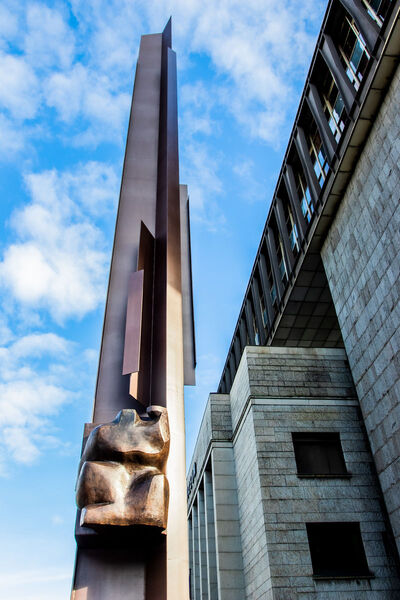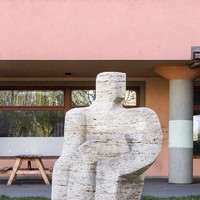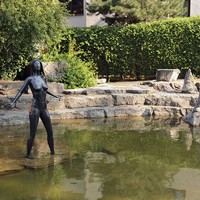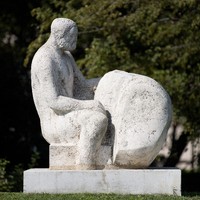Breadcrumbs navigation
Art for Prague - The City of Art
Open your eyes and discover new works of art every day in the streets of Prague. Why not combine a pleasant walk with art? As part of the “Art for the City” project, the Prague City Gallery has created an interactive map which features many public sculptures and other objects all over Prague. Check out the selection of ten sculptures created from the 1960s to the present.
Art is ubiquitous. It has become a permanent part of the public space and of our lives. Every day we pass by, often unnoticed, works of art, whether directly on the street, in parks, in underground spaces, and in public buildings and institutions. Just look around and you'll find you live in a large gallery called Prague! Every city district and every neighborhood has its own unique artwork. Head for an enjoyable walk and find your own. To help you, the Prague City Gallery has created an interactive map as part of the “Art for the City” project, which features many public sculptures and other objects located all over Prague. We've chosen ten works of art, created between the 1960s and today, which are not necessarily the most famous or sought-after, but nevertheless deserve your attention.
Čestmír Suška, Pig on a Walk, 1990, Prague 11
This bronze sculpture on a mounted on a stone in the inner courtyard of a housing estate is the work of sculptor Čestmír Suška, a member of the artistic group Tvrdohlaví. In the 1990s, the sculptor gradually abandoned the creation of figural works and began to create anthropomorphic and zoomorphic shapes using both found and shaped natural materials. The artist’s imagination transformed the sculptural stump into the Pig on a Walk.
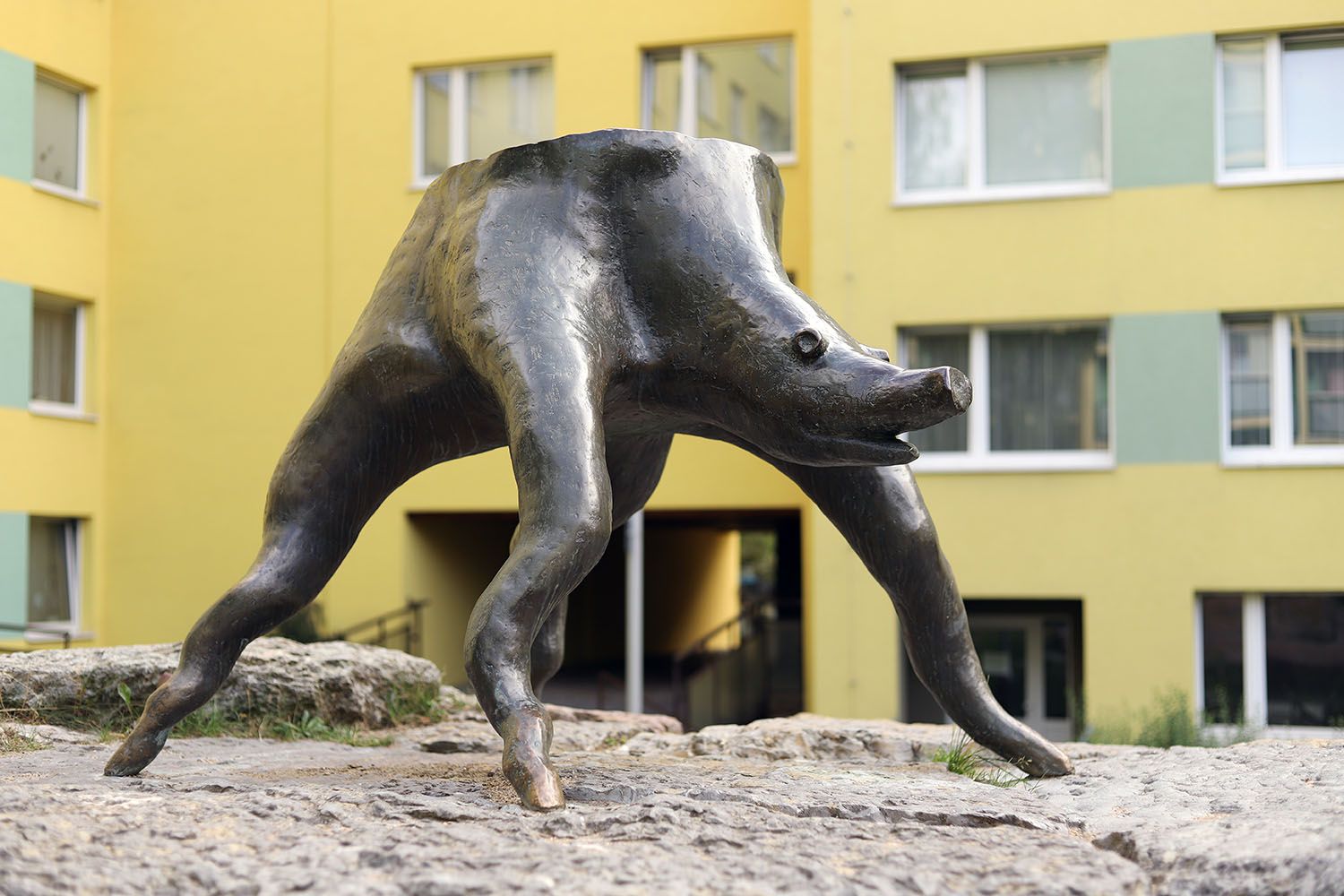
Miroslav Jirava, Lovers, 1966, Prague 3
Lovers was placed at the head of the park in Jarov, near Chmelnice, in 1966. Shortly thereafter, during "Initiative Z” in the 1970s, a sheet-metal fruit and vegetable kiosk was erected alongside the sculptures. Its construction unduly disrupted the contact between the sculpture and the park, and interfered with the ability to view the work of art from multiple angles Thanks to cooperation with Prague 3, the Prague City Gallery was able to move the restored sculpture to the center of the reconstructed park in 2020, where the beauty and tension of the two intertwined figures can once again be fully appreciated.
František Bělský, Airmen’s Memorial, 1995, Prague 6
The memorial to the Czechoslovak airmen who were lost between 1939 and 1945 is located in the Freedom Square (náměstí Svobody) in Prague’s Bubeneč district. The work. by sculptor František Bělský, was dedicated on May 12, 1995. The abstract sculpture symbolizes airplane wings. The names of all 546 Czechoslovak airmen who died in the World War 2 are inscribed on the marble slabs on the sides of the pedestal. František Bělský, who died in 2020, was a renowned artist in the United Kingdom, where he was the only sculptor to portray four generations of members of the royal family.
Martina Hozová, Jan Paclík, Sophia Chotková’s Fan, 2019, Prague 6
A work of art not far from the Powder Gate in honor of Sophia Chotková, countess and wife of the successor to the throne of František Ferdinand d’Este, was selected by a specialist committee in a competition organized by the municipal district of Prague 6. Sculptor Martina Hozová's work combines part of the Chotek family coat of arms - half of a wheel and the spokes with engineering and steam machinery - symbols of the time of rapid technological development in which the countess lived. The cast iron fan is also a water element with a fog function that helps improve the air around it.

Miloslav Chlupáč, Seated Figure, 1973, Novodvorská, Prague 4
The travertine Seated Figure by the academic sculptor Miroslav Chlupáč was part of the design solution of the central space at Novodvorská since 1973. It stood here until the renovation of the space in 2010. During this rather unsuccessful attempt to revitalize the space, the statue was removed and moved to an unknown location. Only a few years later, in 2019, the Vice-Mayor of Prague’s Řeporyje district David Rožnětinsky found the statue by chance at a local technical waste landfill. The vice-mayor traced the statue’s original location and informed the Prague 4 district council of his findings. The Prague 4 district council had the sculpture restored and returned to Novodvorská in 2019.
Jiří Příhoda, Vista Mars, 2017-2019, Rustonka Office Complex, Prague 8
Jiří Příhoda called his workVista Mars – "View of Mars". This rotating multimedia object is the dominant feature of a new space among the buildings of the Rustonka office complex. The surrounding buildings and visitors are reflected in a polished stainless steel enclosure and thus become part of the artwork. Every 360 seconds, a large-scale LED screen with an exterior 360° video projection of the real landscape of Mars rotates to the viewer. The projection data and recordings were taken from NASA. If you walk into the object and climb into the perimeter of the spiral on the imaginary lookout, you will be offered a new view of the Mars surface. Unfortunately, the internal space is not yet accessible to the public.

Kurt Gebauer, Rusalka, 1986, Prague 13
Rusalka, a bronze statue by Kurt Gebauer from 1986, is part of the artifical water feature, originally a fish pond, in the Stodůlky housing estate.. The statue is part of a complete visual solution of what’s know as "Southwest Town”, the architect of which was Ivo Oberstein. The housing estate is home to works by otherleading Czech artists, including Magda Jetelová, Pavel Přikryl, Milan Vácha, and Kurt Gebauer.
David Černý, Tank Chassis, 2018, Kinský Square, Prague 5
The history of the tank on Kinský Square dates back to 1945, when it was placed here as a memorial to the liberation of Prague by the Russian Army. In the 1950s it was even declared a national cultural monument. It lost this status in 1991, when the sculptor David Černý painted it pink. The act did not resonate with the general public, and the tank was finally returned to its original state and later transferred to the Lešany Museum.
In 2001, a pink tank chassis by the same artist appeared on the square. This was an unapproved installation, and was only there for a short time. It reappeared here in 2008 during the Russian-Georgian conflict. Only in 2018 did Tank Chassis find a permanent home in Kinsky Square as a reminder of the period when the Soviets occupied the Czech country.

Marie Učíková, Man with Stone, 1979, Na Petřinách, Prague 6
The travertine statue Man with Stone is the work of the academic sculptor Marie Učiková and dates back to 1979. The sculpture is located in a grassy area in a neighborhood of low apartment houses in Petřiny. The sculpture is very popular with the local residents. Every year when winter arrives, the man receives a freshly-knit hat and a scarf.
Miloslav Chlupáč, Karel Prager, Palach Pylon, 1968 - 2020, Vinohradská, Prague 2
The Palach Pylon, created in February 1968 based on a design by Miloslav Chlupáč and architect Karel Prager as part of the project for the Federal Assembly complex (now the New Building of the National Museum), was finally dedicated on November 17, 2020. The slim steel pylon symbolizes a flame flickering upwards. During the construction of the Federal Assembly complex, the country was occupied the military of the Warsaw Pact in August 1968, followed by the self-immolation of student Jan Palach. This led the authors to make a spontaneous decision to devote this work to Palach.
